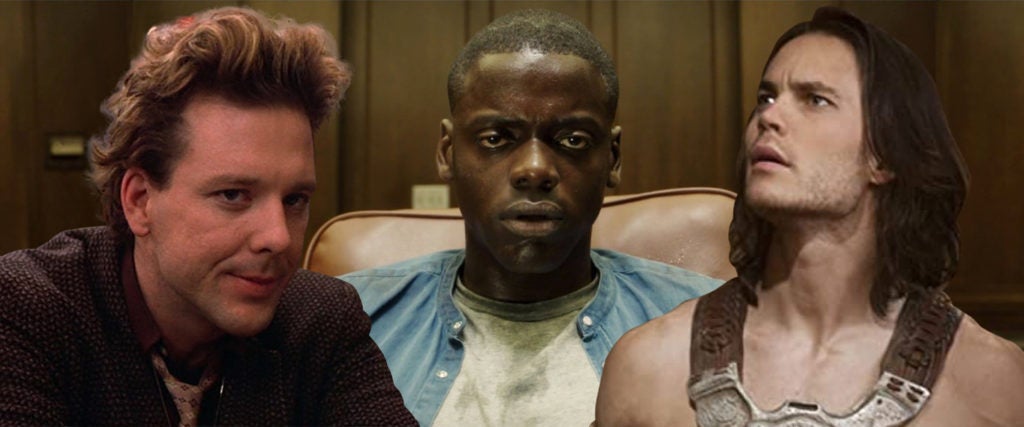We know, we know. It seems like just about every movie that hits the multiplex these days — or that did, back when theaters were open — is a sequel, a reboot or part of a larger “cinematic universe.” But that’s not entirely so! In fact, there are dozens of critically acclaimed, dearly beloved films that have never gotten any kind of follow-up or re-imagining, for a variety of reasons.
Maybe the filmmakers aren’t interested in continuing their stories. Or maybe the movie was supposed to be the first in a series, but it didn’t make enough money to get a green light for a part two. Regardless, for those of us who love these films, we have money in our pockets that we’re eager to spend.
Here are 11 potential movie sequels that we’d gladly queue up to see (once cinemas are a thing again)…
The Rocketeer (1991)
One of the best superhero movies ever made had the misfortune to arrive a couple of decades before the filmgoing public became obsessed with masked men and women. Circa 1991, the model for comic-book pictures was Tim Burton’s Batman: a film at once broadly cartoony and grimly gothic. With The Rocketeer, director Joe Johnston helmed an adaptation of Dave Stevens’ underground adventure comic that stayed true to the original’s retro look and whiz-bang optimism. Set in FDR-era Hollywood, the film takes full advantage of all the old showbiz glamor and pulp kicks inherent in Stevens’ story of a stunt pilot who fights crime with the help of an experimental jetpack.
There are still plenty of tales to tell in this world, and Disney (which made the movie and owns the rights) is currently delivering a kid-sized version with an animated Rocketeer TV series. But while the film’s original stars, Bill Campbell and Jennifer Connelly, are a bit too old to reprise their roles today, it’d still be great to see more of The Rocketeer’s high-flying, good-spirited action on the big screen — preferably directed again by Johnston, who made arguably the best Marvel Cinematic Universe movie with the Rocketeer-esque Captain America: The First Avenger.
John Carter (2012)
Twenty years after The Rocketeer, Disney flopped again with another attempt to turn a classic pulp property into a blockbuster franchise. Despite the best efforts of Pixar director Andrew Stanton (making his first non-animated feature) and a team of screenwriters that included the Pulitzer Prize-winning literary nerd Michael Chabon, this mega-expensive adaptation of Edgar Rice Burroughs’ A Princess of Mars bombed with the critics and underperformed at the box office. (The first sign of trouble? Removing the words “Princess” and “Mars” from the title.)
Honestly though? John Carter was never as bad as its reputation. Star Taylor Kitsch brought some real charisma to the role of a Civil War vet adjusting to life in outer space, and Stanton’s take on old-fashioned science-fiction was full of delightfully imaginative alien creatures and landscapes. Maybe the problem with John Carter was the scale, which was too grand and unwieldy for such a zippy throwback concept. Bring everybody back for the sequel, but this time make it cheap and scrappy.
Miami Blues (1990)
The eccentric crime novelist Charles Willeford wrote four novels about Hoke Moseley, a Miami police sergeant blessed with loose ethics and cursed with bad luck. In 1990, the equally eccentric writer-director George Armitage released an adaptation of the first Moseley book, Miami Blues, with Fred Ward playing the hapless cop and Alec Baldwin playing a slick, ruthless criminal who steals the hero’s identity. The movie wasn’t a hit, but it very quickly became a cult favorite.
Once upon a time — way back in the olden days of 2014 — Paul Giamatti starred as Hoke in a pilot movie of the same name, written and directed by Scott Frank for FX. But the network passed and the pilot never aired, which means that — for now — our only Hoke Moseley movie remains Miami Blues. It’s a great film, but it’s not enough.
Devil in a Blue Dress (1995)
Speaking of a detective series that never was, in a more righteous world we could hop online right now and buy a Blu-ray box set containing about a dozen Easy Rawlins movies, all starring Denzel Washington as the novelist Walter Mosley’s private eye hero, solving mysteries in L.A. from the 1940s to the 1960s. Instead, writer-director Carl Franklin’s superb big screen version of Mosley’s Devil in a Blue Dress — with Don Cheadle as Rawlins’ shady friend “Mouse” — struggled to find an audience back in 1995. And so another potential franchise fizzled. (Weirdly, both Devil in a Blue Dress and Miami Blues were produced by the filmmaker Jonathan Demme. The man had good taste, but perhaps not the keenest commercial instincts.)
There have been a handful of efforts over the years to bring Easy back to the screen, either in a new movie or in a TV series, but nothing has come to fruition. This would seem like a no-brainer: The Mosley source material is excellent (and copious), and these days there’s clearly an audience for intelligent crime sagas featuring strong characters.
Get Out (2017)
And here’s another no-brainer. Even though Get Out’s writer-director Jordan Peele has said he doesn’t want to do a sequel, and even though producer Jason Blum has said he wouldn’t want to make one without Peele, of all the movies from the recent boom of new horror classics, this is the one that would seem most prime for another installment. (It Follows is a close second.) The very fact that Peele considered multiple endings to his story of cross-racial body-possession shows there are other directions where he could go with this premise.
Then there’s this: After a tumultuous summer of protest marches for social justice, there’s clearly a lot more to say about the general state of American race relations and class conflict. The “sunken place” has, somewhat incredibly, sunk even lower in just three years.
Grace of My Heart (1996)
To be fair, writer-director Allison Anders’ neglected masterpiece already covers a lot of ground, spanning over a decade in the life of the fictional singer-songwriter Denise Waverly (played by Illeana Douglas), whose episodic, bicoastal adventures in the pop music scene of the 1960s were inspired by the lives of women like Carole King and Joni Mitchell, and by the difficult men they loved and lost on their way to the top.
But the story ends in the early 1970s, and given how skillfully Anders describes that era’s evolution in American pop, rock and R&B — from slyly subversive girl-groups to psychedelic mad scientists to gentle California grooves — it would be wonderful to see her move on to cover the 1980s and 1990s. It would also be a treat to see Douglas reprise what is maybe her best role.
Little Women (2019)
To be clear, we’re asking here for a sequel to writer-director Greta Gerwig’s version of Little Women — in part because she put her personal stamp on Louisa May Alcott’s classic novel, and in part because if Gerwig got started on it within the next few years, her star Saoirse Ronan could roll right into the next picture and remain age-appropriate. (The same cannot be said of the versions starring Katharine Hepburn, June Allyson or Winona Ryder, as much as we love all those ladies.)
Plus, as Alcott fans know, she actually wrote two sequels to Little Women, both featuring Jo March: Little Men and Jo’s Boys. Both have been adapted to the screen, but never as memorably as any of the movie versions of Little Women. As the titles suggest, these books are more focused on young males than on the camaraderie of the March sisters, but there’s still a lot that Gerwig and Ronan could bring to them.
The Grand Budapest Hotel (2014)
To be honest, we’d be interested in a sequel to any Wes Anderson movie. The writer-director creates such a singular cinematic universe — in terms of how his films look and who populates them — that one could argue that each of his projects follows logically from the one before. Still, part of the pleasure of watching one of his pictures is that even though the images inside the frame are precisely arranged, the characters and stories are so richly imagined that they seem to sprawl beyond the opening and closing credits.
In the case of The Grand Budapest Hotel — Anderson’s biggest box office hit to date — the European resort in the movie’s title is shown in multiple eras. While the narrative focuses on the effects of creeping 1930s fascism on a picturesque wonderland, it’s clear there are many more anecdotes and personalities that Anderson could’ve introduced if he’d had the time. Perhaps his COVID-delayed triptych film The French Dispatch — also set in a tumultuous Europe — will cover similar territory.
A Bug’s Life (1998)
Pixar’s Toy Story redefined what an animated movie could be and the studio’s Toy Story 2 kicked off what would be a solid decade of timeless classics. But A Bug’s Life — while a massive hit at the time, and while still well-represented in Disney’s theme parks — doesn’t get the love it deserves as a rousing and hilarious action-comedy, inspired by both Aesop’s “The Ant and the Grasshopper” and Akira Kurosawa’s The Seven Samurai.
So let’s remedy that! Nearly every other smash hit Pixar movie (aside from obvious one-offs like WALL-E, Up, Ratatouille, Coco and Inside-Out) has gotten a sequel. Given the recent advances in realistic CGI rendering, it’d be a real treat to see what the studio’s geniuses could do today with Flick, Atta, Dot, Slim, Rosie, Molt and the rest. (Thankfully Hopper, voiced by the highly problematic Kevin Spacey, was killed in the first film.)
Boyhood (2014)
Listen, for all we know, Boyhood writer-director Richard Linklater already is filming a sequel, and we just haven’t heard about it yet. After all, he shot the first movie mostly on the sly, gathering the cast for a few weeks a year over the course of 12 years. Who’s to say that he’s not still tracking the story of his artsy young Texas protagonist Mason Evans Jr., as he grows into Adulthood?
That would be a must-see film, for sure. It’d also be awesome if Linklater (or somebody else) started over with another kid of a different gender and made Girlhood. We do know that Linklater is making a version of Stephen Sondheim’s decade-spanning musical Merrily We Roll Along in a Boyhood-like fashion, filming Ben Platt, Blake Jenner and Beanie Feldstein a little bit every year. Maybe that counts!
Diner (1982)
Writer-director Barry Levinson based his feature filmmaking debut on his memories of hanging out with his buddies in Baltimore in the late 1950s and early 1960s, and it’s not too much of a stretch to say that Levinson’s overlooked masterpiece Tin Men (set in 1963) imagines those same guys he grew up with as middle-aged, middle-class salesmen. But let’s not overstate the case: Tin Men is in no way a Diner sequel.
Given how open-ended and anecdotal Diner is, it’s not hard to imagine a whole series of movies where Levinson revisits his motley assortment of arrested adolescent young men at different stages of their lives: in their 30s, 40s and beyond. That said, the original cast (which included Daniel Stern, Kevin Bacon, Mickey Rourke, Tim Daly and Steve Guttenberg) are in their 60s now, so if Levinson wanted to bring back those guys for a reunion movie, he’d have to set it at the turn of the millennium.
Still, would watch!

